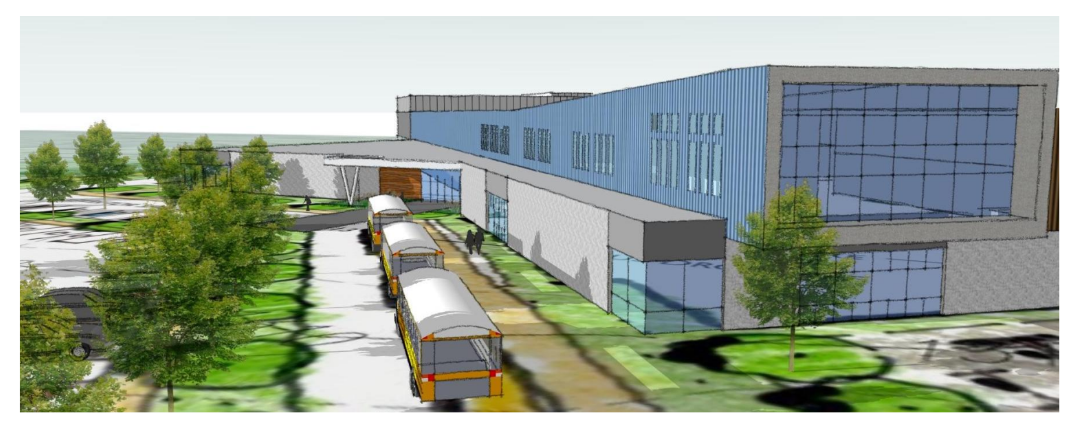Career center has a place and a plan, now needs permission
April 3, 2025 | By David Delcore | Times Argus staff writerBARRE — The runway is incredibly short, the landing strip could be gone before it’s time to touch down, but plans to relocate the Central Vermont Career Center are preparing for takeoff.
Architect's sketch of the proposed new Central Vermont Career Center front/side view. Courtesy photo
Undaunted by a potential legislative moratorium on new construction that is under consideration, the autonomous 18-town school district, which operates the Barre-based career center, has its sights set on a November bond vote. The six towns of the Harwood Unified Union School District are part of the career center district.
It’s an aggressive timeline for a project that doesn’t yet have a price tag, and about which many questions have yet to be answered.
However, the CVCC School Board’s facilities committee was told by its consultant on Tuesday night, that those answers will start to come quickly — some already have — and Burlington architect David Epstein predicted board members would be in a position to decide whether to schedule a special election in November by the end of September.
That leaves six months to flesh out the design of a new center, determine how much it would cost to construct, and assess how it could fit into an evolving vision for public education that is anything but certain at this stage in the legislative session.
With a 27-acre property off Baptist Street in Graniteville under option, and conceptual designs in hand, Epstein told committee members a years-long conversation has reached an important pivot point.
“It’s going to get so much more interesting now,” he said of a project that, if successful, would create a modern new home for the regional center, which has operated out of a wing of Spaulding High School in Barre since it opened in 1969.
Thanks to a recently executed option agreement, the district has until July 31, 2027, to purchase the Baptist Street property owned by Alan Garceau, and his wife, Cindy. The property currently includes the Garceaus’ home, which would be razed if the project proceeds, and roughly 27 acres of undeveloped land that, at first blush, appears suitable for a building that would more than triple the size of the center, and accommodate full-day programming for its students.
This Google map notes the parcel location with the red pin. Click to enlarge.
That isn’t possible at Spaulding, where the roughly 44,000-square-foot wing the center occupies has limited its ability to meet the growing demand for career technical education, or CTE.
Last year, 424 students from six sending high schools applied to attend the regional center, which could only accommodate 220 of them. So far this year, 334 students have applied to attend the center next year, and 176 have been accepted. There will be two more rounds of applications.
Superintendent Jody Emerson said Wednesday the new building that was reflected in conceptual plans the committee reviewed this week would change that if it is ever built.
A big “if” to begin with, Emerson said it is bigger still given competing education reform proposals now being discussed in the Legislature, and the call for the three-year moratorium on the construction of any new CTE centers.
Emerson said she, her board, and its committee, have tried to stay focused.
“It’s hard to know what the best thing is for the future, but we know that CTE is gaining in popularity across the country … as we need this workforce, and we need to find space to be able to do it, and not keep turning kids away,” she said.
Though plans for a November bond vote could come off the rails, the district paid $10,000 for the option to acquire Garceaus’ property, and are eager to learn more about it. There is a known wetland on a portion of the property, and fully delineating it later this month could alter the proposed design.
Due to the slightly sloped nature of the land the design the committee reviewed features a second floor with a 100,000-square-foot footprint, that is roughly double the size of the first floor.
Committee members were told a phase 1 site assessment is in the works, a traffic study will no doubt be needed, and the intersection of Baptist Street and Graniteville Road will be a particular focus.
The proposed building would use two existing drives to create an entrance- and exit-only for the center.
The land, once owned by Rock of Ages, isn’t far from quarries and, while the proposed center would be a source of new traffic, it shouldn’t be alarming to residents.
“This isn’t like a pristine area that’s never seen a truck,” he said, though he suggested a meeting with neighbors — particularly those with homes near the proposed entrance and exit to the school would be wise.
“There’s going to be a fair amount of traffic impacting (those) five houses,” he said. “They might get a little upset about it.”
As they prepare for the public rollout of a project that could be on the ballots in 18 central Vermont towns in November, the consulting team—which includes Epstein’s firm TruexCullins, and Lavallee Brensinger Architects of Essex Junction—planned to join Emerson for a noon meeting with officials in Barre Town.
Briefing town officials on what would be a major project in one corner of the community, was a courtesy and a chance to determine whether the proposal raised any red flags from a permitting perspective.
The project will need a state land uses permit, but Epstein told the committee that process can’t start until the wetland is delineated, and the site assessment is complete.
Epstein said he hoped to have cost estimates by June 1, while acknowledging the window for holding a bond vote in November will close quickly. “It doesn’t leave a lot of time to get the word out, but it’s doable,” he said.
Given the uncertainty on the legislative front, Epstein said he’d rather hurry up than wait. “I think there’s a definite sense of urgency in terms of: ‘before they (lawmakers) pull the rug out’ get this [bond] in front of the voters,” he told the committee.
On Wednesday, Emerson said her board has identified a need, selected a site, and was gearing up for a bond vote in November, even as lawmakers entertain a moratorium. “It’s exciting, and a little scary because at any moment, we might have to stop,” she said.
This story was originally published by the Times Argus.

